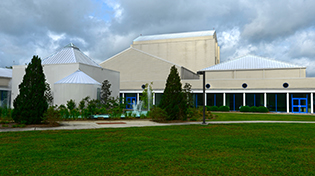Facilities
The Department of Art and Design is housed within the Center for Fine and Performing Arts along with the Department of Theatre and the Dr. Grier Williams School of Music. The facilities within the CFPA offer secure 24-hour access to most studios, ample working space, and opportunities to work with a variety of tools and equipment.
The Center for Fine and Performing Arts

The Center for Fine and Performing Arts contains three performance spaces as well as the UWF Art Gallery that has approximately 1500 square feet of exhibition space. Performance spaces include the Music Hall, a 309 seat acoustic recital hall, the Mainstage Theatre with a capacity of 442, and the Studio Theatre, a true black box space with adjustable seating. These performance spaces, and the UWF Art Gallery are centrally located within the building.
The facilities at the UWF Department of Art and Design offer secure 24-hour access to most studios, ample working space, and opportunities to work with a variety of tools and equipment. Please see below to explore the individual studios.
Printmaking

The printmaking studio features professional intaglio and lithography presses. About eight years ago, the etching equipment used in intaglio was converted to utilize the modern non-toxic methods, advocated by professional printing organizations. The studio also provides opportunities to explore mono prints, serigraphy (silkscreen), and book art, as well as the new digital technology applied to the older printing methods.
Painting/Drawing

The painting and drawing studios are adjacent and connected to provide maximum flexibility. These well-lit studios provide approximately 1000 sq. ft. of space. Classes held in this area are limited to 20 students, offering the guarantee that each student will receive ample space, access to tools and instruction.
Digital Lab

The Digital Lab is used often as a bridge between tradition and experimentation within the context of the photographic medium, printmaking, 2-D and 3-D processes. Digital Art and Graphic Design students are provided with monitored access to the studios and strong technical support from the University. Classes are kept small, 20 students or less, and the machines are updated regularly with the latest standards in design, video, sound editing and web design software. Students explore the possibilities of still image, moving image, and graphics in a recently renovated, state of the art facility.
Sculpture

Separate studios are maintained for metal and wood sculpture. Our metal studio contains all the necessary tools for traditional large-scale metal sculptures fabrication. The woodshop is a separate structure, located in the courtyard. The studio is well equipped with power tools and equipment necessary for most additive or subtractive woodworking processes. We also have indoor and outdoor facilities for plaster working, mold making, and alternative casting processes.
Ceramics

The areas devoted to ceramics house courses in traditional wheel throwing, and hand building techniques, as well as sculptural ceramics. Students actively enrolled in a ceramics class are given the privilege to enjoy 24-hour access to this large and well-equipped studio. Classes explore a wide range of glazing and firing techniques using a variety of small, hand-built kilns and large capacity, high-fire electric and gas kilns.
Photography
The Photography studio incorporates digital with traditional processes. Darkroom facilities are well equipped for Black and White wet lab processing and analog photography, using film and other light sensitive materials. Courses in Digital Photography begin in the computer labs (see below), and are completed on-line.
SEA Makerspace
The SEA Makerspace is a creative studio is operated by the UWF Department of Art and Design in Historic Downtown Pensacola. The studio is devoted to interdisciplinary practice—the SEA is an acronym for ‘science, engineering, and art’ in recognition of our commitment to creative collaboration. The SEA Makerspace studio is located within the Museum of Commerce adjacent to the SEA 3D Additive Lab and Department of Mechanical Engineering SEA CNC Lab.


